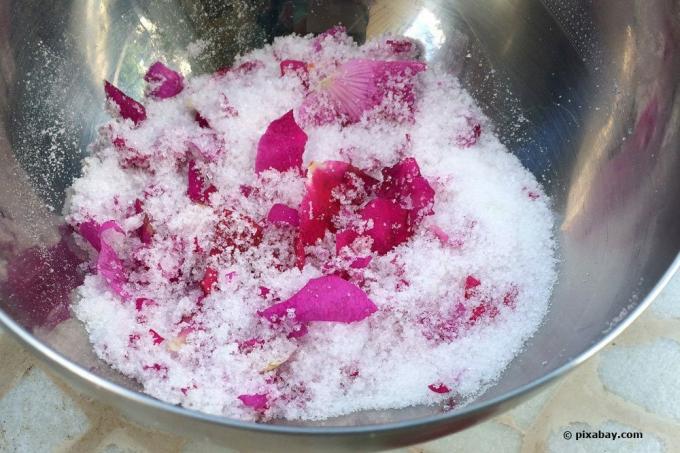
table of contents
- Dry rose petals
- Decorative rose petals
- Drying with desiccant
- Oven with sand
- microwave
- Press flowers
- Head-over method
- Personal care products
- Oven method without sand
- Air drying
- Dehydrator
- Rose petals for eating
- Candying rose petals
- Rose sugar and rose salt
Roses are among the finest and most beautiful flowers. If you are of the same opinion, you must be very interested in preserving the beauty of these flowers for as long as possible. There are many ways to preserve flowers for long periods of time, and drying is one of them. This method is particularly suitable for roses, as the fragrance and the colors of the flowers are also preserved. In addition, dried rose petals can be used in a variety of ways.
Dry rose petals
Before deciding on a dry method, you should think about the further uses of the petals. You can use them for this after drying:
- as living room decoration or for creative design
- for personal care products such as bath salts or soap
- for consumption or as a decoration for cakes and muffins
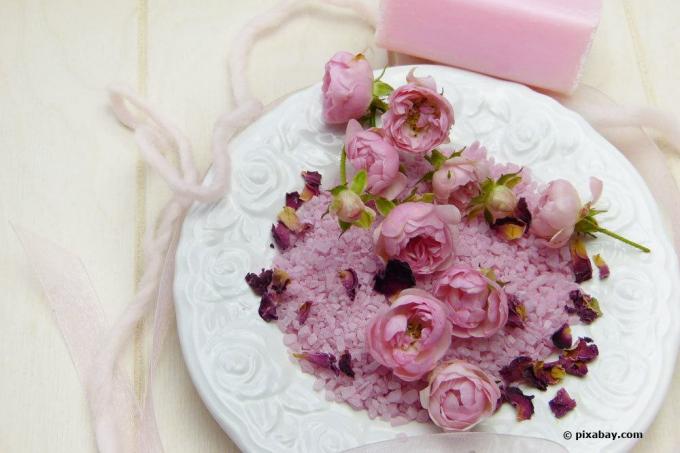
It is always important to store the finished rose petals in a dry place. This can be done with paper bags, tightly fitting glasses or ground into powder in plastic cans. If the flowers are used as room decorations or to decorate handicrafts, they can be made durable with hairspray or clear varnish.
Decorative rose petals
Methods that are suitable:
- Drying with desiccants
- Oven with sand
- microwave
- Book method / flower press
- Overhead method / air drying
Drying with desiccant
All you need is the rose petals, a desiccant of your choice and a tightly fitting can. Pour the chosen desiccant into a can until the bottom is covered. Place the clean and dry rose petals on top. The petals shouldn't be touching. Pour another thick layer of desiccant into the can and seal it. The drying process takes 2 to 3 weeks.
Suitable desiccants are:
- Special dry salt (available from florists)
- Silica gel (located in the small drying bags that are supplied with shoes, for example)
- laundry detergent
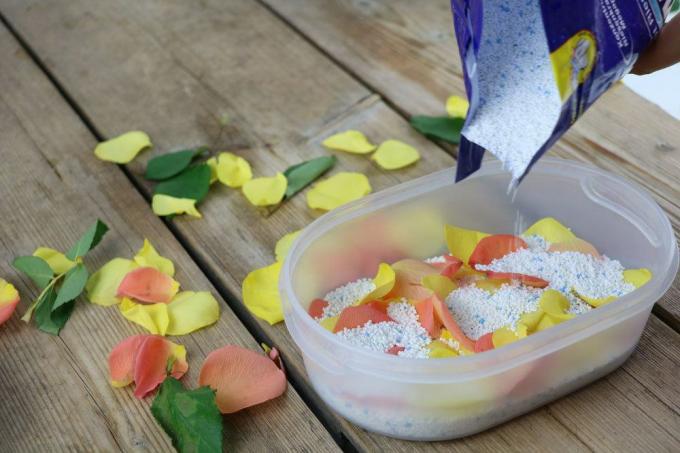
All of these funds are characterized by the fact that they absorb moisture in themselves. Salt and silica gel can later be dried in the oven and thus reused.
The finished petals are ideal for decorating your home, for example in a potpourri. The color may be a little weaker and if detergent has been used, the fragrance of the rose petals can be lost. However, these drying methods are not suitable for personal care products or to consume the flowers afterwards.
Oven with sand
All you need is your kitchen oven and ordinary, fine sand. Scatter the sand on a baking sheet, spread the petals on it, and sprinkle more sand on the roses.
The petals are dried at around 40 degrees. The sand removes additional moisture from the petals and speeds up the process. After 30 minutes, the rose petals should be dry.
Note: Since the petals may contain sand, they are not suitable for consumption or personal hygiene.
microwave
For this you need your flower petals, two sheets of kitchen paper, two microwave-safe plates and your microwave.
tip: As an alternative to the plates, you can use fireproof tiles with a smooth surface.
Place a sheet of kitchen paper on one of the plates, spread the petals on it and cover with the second paper towel. Carefully place the second plate on top.
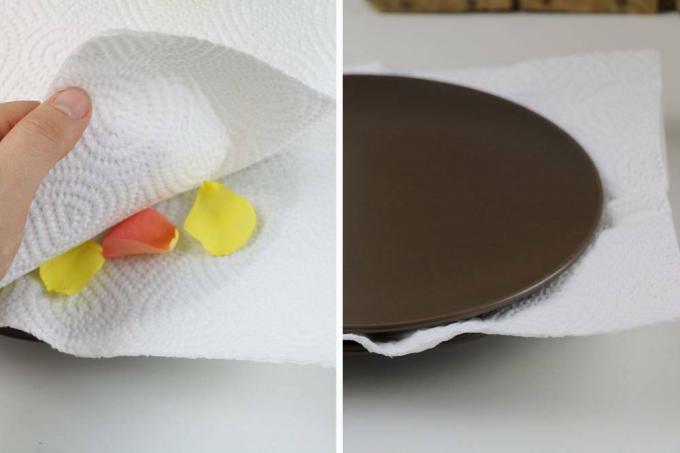
Place the tiles in the microwave for 40 to 90 seconds. Better look a little earlier. The plates flatten the leaves and lose their beautiful curvature. The method is particularly quick and suitable for all areas of application.

Press flowers
Book method
The book or press method is particularly popular for pressing various flowers and leaves. Roses can also be dried with it. In addition to the thick books, it is essential to use kitchen paper or old newspapers to avoid damaging the book pages with moisture. Place the paper towels in the middle of the book. Place the petals on top and cover them with another paper towel. Close the book and weigh it down with more books.
Flower press
Another option is the flower press, which works similarly to the book method. You can buy flower presses from creative supplies or build them yourself. They consist of several wooden discs, which have holes. Screws get into the bores, the more they are tightened, the higher the pressure during pressing. The petals are distributed on the individual wooden discs.
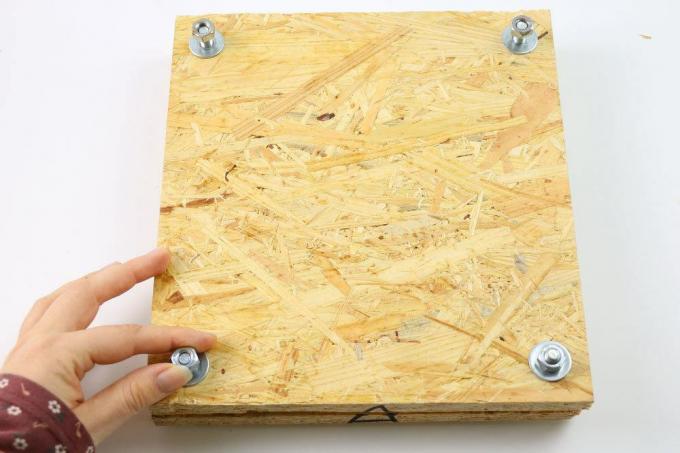
Both pressing methods are particularly suitable for creative design. You can stick pictures or cards with the finished flowers. However, you need to allow a few days to weeks of drying time.
Head-over method
This method is suitable when you want to dry whole bouquets of roses. It is particularly important here that you do not miss the right time. The roses should already open, but not be fully bloomed. If the roses are about to fade, they can no longer be dried out well. They could lose their leaves or turn brown during the dry season.
proceed
Tie the rose stems together with string. To protect them from dust, you can wrap a layer of newspaper around the bouquet. Hang the bouquet upside down in an airy, not too warm place. Do not hang them in the sun; the colors will fade.
With this method, however, you have to assume that the roses will turn slightly brown in color as they dry.
Dried bouquets are good for decorating your living room, but they can also be used as drying arrangements.

Personal care products
Only methods that are non-toxic should be used. Ready-made rose petals can be mixed with bath salt or poured into soap mass.
Methods:
- Oven without sand
- Air drying
- Dehydrator
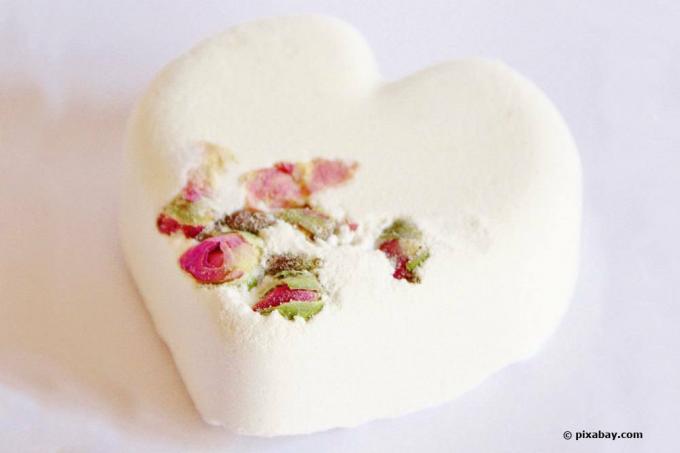
Oven method without sand
Line a baking sheet with parchment paper and sprinkle the petals on it. Put the tray in the oven at 40 degrees and leave the door ajar so that the moisture can escape. It will take some time to dry, so turn the petals back and forth, being careful not to turn them brown.
Air drying
You can buy a grid for this or build one yourself from flywire. Another option is newspaper or kitchen paper. However, the air circulation is better with grilles. A dry, airy and dark place in the house is best suited as a place. Rose petals can be dried outdoors when the weather is nice, but gusts of wind can blow the petals away.
Do not place the petals too close to the grid or paper and let them sit for a few days. Apply them every now and then and check the consistency. They're done when they rustle.
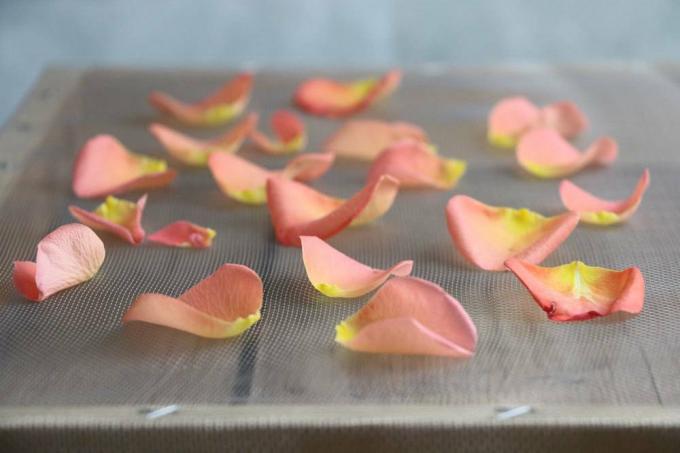
Dehydrator
A dehydrator is popular in households that mainly dry a variety of foods. But it is also suitable for rose petals. It's a clean, simple process that uses a lot of electricity. The dehydrator contains various grids on which the petals or whole flowers are placed. The grids are assembled and the device is turned on. Modern dehydrators can be set to the perfect drying temperature.
Dehydrators not only work with heat, they also have ventilation that makes turning them superfluous. Leaves dried with a dehydrator are also suitable for consumption.
Rose petals for eating
Only rose petals from the garden are suitable for consumption. Roses from the florist are often sprayed and should not be eaten! It is also important to only use non-toxic drying methods. In addition to the dehydrator and air drying, there are the following methods:
- Candying with egg white or sugar solution
- Production of rose sugar / salt
Candying rose petals
You can use egg white and fine sugar or water and sugar for this. If you want to use egg white, proceed as follows:
- Sprinkle a baking sheet with sugar
- Brush the clean petals with egg white
- Place the leaves on the baking sheet
- Sprinkle a thick layer of sugar on top
- Let the rose petals dry
Using sugar and water, cook a clear syrup from them. Dip the rose petals in the cold sugar solution. You can use leaves or whole flowers. You should twist and turn the latter well so that the syrup goes everywhere. You can brush leaves on with a brush. Whole blossoms dry standing in a glass, petals dry on a baking sheet lined with baking paper.
Rose sugar and rose salt
Both salt and sugar are suitable for drying because they draw water out of the petals. You can use the same method as with special dry salt. You can then grind the sugar and rose petals together in a mortar. Let the mixture dry a little longer on a baking sheet and store it in tightly fitting jars.
